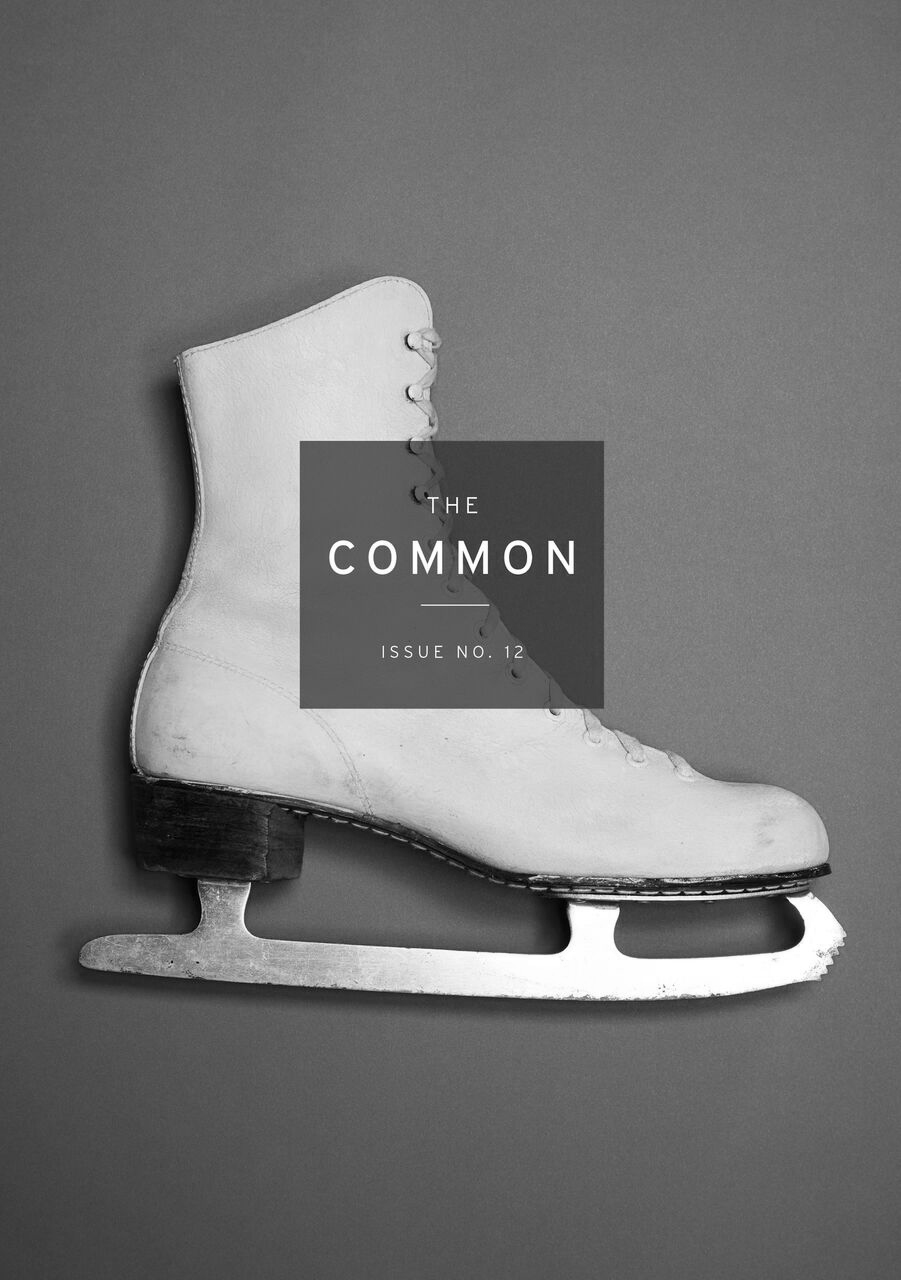

Splashed with a soft, cotton red and superimposed by a lonesome ice skate, the front flap of the 12th issue of “The Common” speaks of a coolly detached professionalism that attends the small, physical body of this publication in sight and feel. It is specifically that misleading nonchalance that may incline the potential reader to think that the skate emblemizes some central mystery that the pages will slowly investigate and resolve. At least, it points to an unrelated but nonetheless unifying ambition that informs the prose, poetry and ponderings contained within.
However, the very first piece of prose fiction makes it delightfully clear that this issue is not beholden to such expectations. The story, “Tell me Please,” consists of a quiet conversation and a quieter interpretation, and it is written from the perspective of a young woman who unsuccessfully attempts to cling onto the mood of her simpler childhood through interactions with a childhood friend. In its essence, it is a small story about the failure of communication that one may otherwise experience and forget. Each exchange between the two characters actively disrupts the thoughtless calm of standard interactions and emphasizes the important, transient emotions that inform the rest of the issue. The poem “Seventh Day Adventist Kids are Pathfinders, not Scouts,” along with other entries found later in the issue carries the disruptive torch as it smoothly transitions from a scene of a formal religious lesson to that of a crass personal encounter. In the process of this transition, the divinely inspired is discovered in the unchurched outdoors. It’s about a casual act of transgression, but in the context of the rest of the issue, it is another instance expressing the particular and personal vigilance surrounding current events at the time of this issue’s circulation.
This emotional awareness more or less serves as the needle that threads the fabric of the collection, which in most other respects comports itself as an eclectic assortment of smaller stories from around the world. The diversity it casually flaunts situates itself in the flourishing discourses about race, gender and sexuality on college campuses and elsewhere, and it enthusiastically tithes contributions to this dialogue with varying degrees of subtlety. “Selections by Rico Gatson” prefaces its own introductory paragraph with a quote by Ta-Nehisi Coates and proceeds to present a gallery of pieces of visual art haloing prominent black figures like Muhammad Ali and James Baldwin with simple, stark lines drawn across blank white pages. The introduction, penned by David Little, neatly and rather explicitly lays out the project’s aim to celebrate blackness as a corrective against the stifling culture of white supremacy and its tendency to appropriate and exploit the heroes of marginalized communities. “Mary with Swag” pursues similar ends in gender discourse, proudly proclaiming the resilience of the woman’s body and mind in constant confrontations with time and pain. Other entries like the poem “Pegasus” prefers the culturally charged metaphor of the mythical steed to bring attention to the sexual tension that arises in the face of the strange and dangerous. “Virgil’s Tattoo” similarly recounts a fictive and deathly inclined anecdote about the poet Virgil getting a tattoo after Augustus destroys his art, all the while charting issues of personal betrayal and state censorship.
In short, there is diversity in the way the issue addresses diversity. Part sermon, part riddle, part unmetered limerick; the sum is more than its parts. Because of the measured and humble scope of the issue’s ambition, the issue may appear unambitious at times. After all, the messages of many of the stories, no matter how cleverly abstracted, remain clear, confident and most importantly, familiar. Because the stories are small, their themes inevitably have smaller rooms in which to play. As a result, clarity — moral and otherwise — informs much of the aesthetic of the stories. The excerpt from “The Afterlife of Stars” and the essay “The Storytelling Animal” are continuously entangled with history and geography, and they elucidate the personal grievances that refer to the greater cultural context. They are also narrated by personalities with lived, imagined and interpreted experiences not significantly distinguished from their authors. As a result, the issue is home to only a few memorable characters with interior worlds distinct from the authorial perspective and voice. That scarcity speaks of a larger absence of devices to complicate and de-familiarize the stories and challenge the reader who may already share the views and presumptions of the already loud and clear authors.
Additionally, but not significantly, there is a sense that the entries themselves could have been better organized. Prose, poetry and essay splice into one another in a supposed attempt to constantly to maintain the interest of the reader. But on the note of transgression and experimentation, it could have been interesting to make playful use of the very structure of the collection and order the works so that each might critique and/or complement its neighbor. For example, “Every Month is Black History Month” could have been set as an epilogue to the display of Ali and Baldwin, and it would have contrasted the veneration of individuals with the dissonant estrangement of them from their respective heritage and furthered the acuteness of the injustice felt by affected communities.
All things being said, however, this issue’s flaws arise from engaging with it in terms that are not its own. After all, the 12th issue of “The Common” evidently prefers the dialect of recalling and cherishing the minor and the marginal, and each sincere constituent attests to its fluency. Each story stands in cooperation and solidarity of the adjacent, building a cumulative case for inclusivity in varying volumes and tones. In a sense, it’s a microcosm of its own emergent message, and the collection itself ultimately is a smaller link in the greater chain of literary work motivated by the positive drive to represent the colorful spectrum of experience. In an important sense, perhaps that’s all the playful use of structure the issue needs.